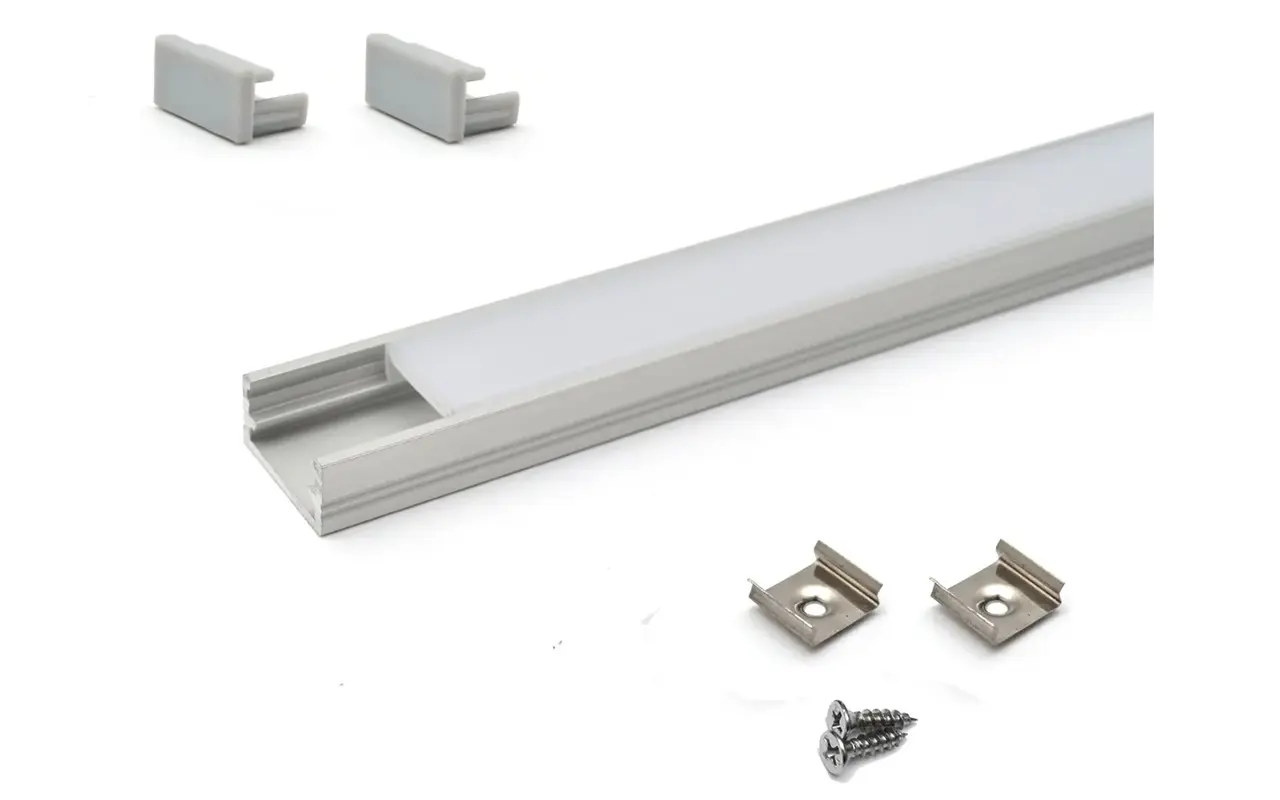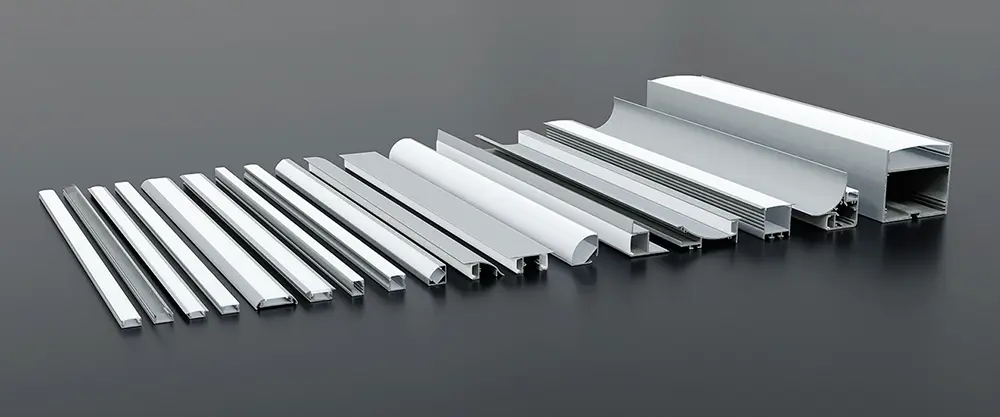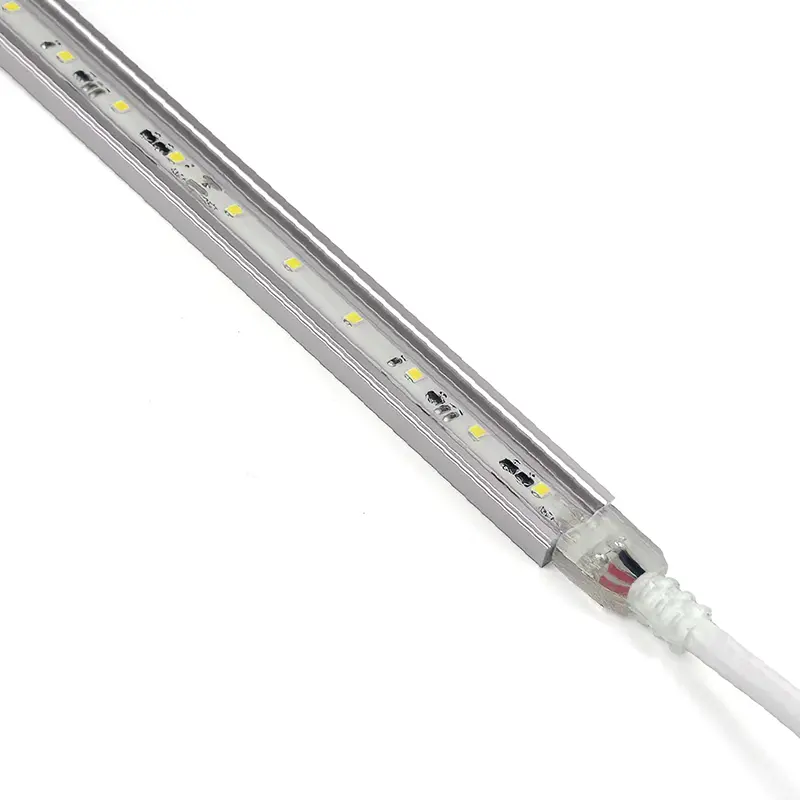If you’ve ever wondered how to elevate your LED strip lighting, LED profiles are the key. This guide will walk you through everything you need to know about enhancing and protecting your LED strip lights with profiles.
Using LED profiles with strip lights is essential for achieving optimal light distribution, heat management, and a polished look, while also providing protection and extending the lifespan of the lights.
Keep reading to explore the advantages and considerations of using LED profiles, ensuring your lighting project shines in both functionality and design.
Introduction to LED Profiles
When embarking on any LED strip light project, understanding the role and benefits of LED profiles is pivotal. LED profiles, also known as LED channels or extrusions, serve a dual purpose. Primarily, they act as protective housing for LED strip lights, shielding them from environmental factors and physical damage. Beyond protection, LED profiles play a crucial role in the overall aesthetics and functionality of the lighting setup. They provide a structured, clean look while enhancing the light output through diffusion and heat management.
The inclusion of LED profiles in lighting projects is not merely a matter of preference but a strategic decision to enhance the durability, appearance, and efficiency of LED lighting solutions. Whether for residential ambiance, commercial displays, or intricate architectural projects, LED profiles elevate the standard of lighting installations, making them a staple in professional LED setups.
Why Opt for an LED Profile?
The decision to incorporate LED profiles into your lighting project brings multiple benefits, significantly impacting the quality and longevity of the installation.
Improved Light Diffusion and Reduced Glare: One of the most immediate benefits of using an LED profile is its ability to diffuse light. This diffusion process smooths out the light output, creating a consistent, even glow that eliminates harsh points of light and reduces glare. This not only improves the visual comfort but also enhances the overall ambiance of a space.
Enhanced Durability and Protection Against Physical Damage: LED strips are delicate; without proper protection, they are susceptible to damage. LED profiles offer a robust shield against physical impacts, dust, and water splashes, thereby extending the operational life of the LED strips.
Effective Heat Management for Longer Lifespan: Heat is a known adversary of LED performance. LED profiles, especially those made from aluminum, act as an excellent heat sink. By dissipating the heat generated by the LEDs, profiles prevent overheating, thus preserving the LEDs’ brightness and color over time and extending their lifespan.
Aesthetic Enhancements with Sleek Finishes: Beyond functionality, LED profiles contribute significantly to the aesthetic appeal of a lighting installation. Available in various finishes and designs, they can complement any decor style, from modern minimalist to rustic charm, adding a polished, professional look to the LED strip installations.
Key Benefits of Light Diffusion Through Profiles
The process of light diffusion through profiles transforms the sharp, direct light from LED strips into a soft, uniform glow. This diffusion eliminates hotspots, creating a continuous line of light that enhances the visual appeal of a space. Whether it’s under cabinet lighting in a kitchen, accent lighting in a living room, or task lighting in a workspace, diffused light improves the ambiance and functionality of these environments.
Consider, for example, a museum or art gallery where focused, non-glaring lighting is essential to showcase artworks accurately. Here, LED profiles with diffused lighting can illuminate pieces without overwhelming them with brightness or creating distracting shadows. Similarly, in a residential setting, a living room with diffused LED lighting under shelves or around entertainment units can create a warm, inviting atmosphere conducive to relaxation and socializing.
The Impact of Profiles on LED Lifespan
The role of LED profiles in heat management cannot be overstated. By acting as a heat sink, profiles efficiently pull heat away from the LED strip, dispersing it along the profile’s length and into the surrounding air. This heat dissipation is crucial for maintaining the LEDs at optimal operating temperatures, thereby preventing premature degradation of the diodes and ensuring consistent light output over time.
Real-world applications vividly illustrate the lifespan extension provided by effective heat management. In commercial settings, such as retail stores or office spaces where LED lights often run for extended periods, profiles have been instrumental in reducing maintenance and replacement costs. Similarly, in outdoor applications where temperature fluctuations are more pronounced, LED profiles safeguard the strips against the thermal stress of changing conditions, thereby prolonging their durability and reliability.
By understanding and leveraging the protective and enhancing capabilities of LED profiles, lighting projects can achieve not only a superior visual outcome but also an economically and environmentally sustainable solution.
Selecting the Right LED Profile for Your Needs
Choosing the correct LED profile is a nuanced process that demands consideration of various factors to ensure the lighting achieves its intended purpose, both functionally and aesthetically. Material, size, and cover type are primary considerations, along with the specific application environment, whether indoor or outdoor. Additionally, ensuring that the profile is compatible with the dimensions of the LED strip is crucial for a seamless installation. The variety of profiles available, including recessed, surface-mounted, and corner options, offer flexibility to match any design requirement.
Material: The choice of material for an LED profile can significantly affect its thermal management capabilities, durability, and overall aesthetic. Aluminum profiles are renowned for their excellent heat dissipation, which is vital for maintaining LED efficiency and lifespan. Plastic profiles, while not as effective in heat management, can be more cost-effective and offer different aesthetic options.
Size and Cover Type: The size of the profile needs to match the LED strip’s dimensions closely to ensure a snug fit that prevents light leakage and optimizes diffusion. The cover type, whether clear, frosted, or opaque, affects the light’s diffusion and intensity. Frosted covers, for instance, provide a soft, evenly diffused light that is ideal for creating ambient lighting.
Indoor vs. Outdoor Applications: For outdoor applications, choosing profiles with higher durability and weather resistance is essential. Aluminum profiles with an IP rating suitable for outdoor use ensure longevity even in harsh weather conditions. Indoor profiles can be selected with more focus on aesthetics and design integration.
Compatibility with LED Strip Dimensions: Ensuring that the profile can accommodate the width and height of the LED strip is paramount. This compatibility prevents the strip from being cramped or poorly seated, which can affect light output and heat dissipation.
Profile Types: The choice between recessed, surface-mounted, or corner profiles depends on the desired visual effect and the installation surface. Recessed profiles are ideal for sleek, minimalist designs where the light source is not directly visible, while surface-mounted and corner profiles are suitable for more pronounced lighting effects and ease of installation.
Spotlight on Aesthetic Appeal
The aesthetic contribution of LED profiles to a lighting project is substantial. By using diffusers, profiles can soften and spread light evenly, eliminating harsh shadows and creating a pleasant visual experience. This diffused light plays a significant role in setting the mood and ambiance of a space, whether it’s a cozy home setting or a professional business environment.
The Role of Diffusers in Light Quality: Diffusers are integral to achieving a uniform light distribution. They work by scattering the light emitted from the LED strip, which softens the light’s intensity and spreads it over a wider area. This diffusion creates a smooth, glare-free lighting effect that enhances visual comfort.
Matching Profiles to Architectural Styles: The design and finish of LED profiles can complement or contrast with the architectural style of a space. For modern, minimalist interiors, sleek aluminum profiles with a matte finish may be ideal. For more traditional settings, profiles with ornate designs or finishes that mimic materials like wood or stone can add a touch of elegance.
Choosing Between Aluminum and Plastic Profiles
When selecting an LED profile, the choice between aluminum and plastic materials plays a critical role in determining the project’s success in terms of aesthetics, functionality, and longevity.
Pros and Cons of Each Material Type: Aluminum profiles are favored for their durability and superior heat dissipation properties. They are ideal for applications where long LED strip life and high performance are priorities. However, they may come at a higher cost compared to plastic profiles. Plastic profiles, on the other hand, offer a lightweight and often less expensive option. They come in various colors and finishes, allowing for more flexibility in design. However, their heat dissipation capabilities are generally inferior to those of aluminum profiles, which could affect the LED strip’s longevity.
Situational Recommendations for Material Selection: For high-demand environments or outdoor applications where temperature fluctuations and exposure to elements are concerns, aluminum profiles are the recommended choice due to their robustness and efficient heat management. In contrast, for interior decorative lighting, where the heat output is minimal, and the focus is on color and design flexibility, plastic profiles may be a suitable and cost-effective option.
This detailed selection guide aims to assist in navigating the myriad of considerations when choosing the right LED profile, ensuring that both functional needs and aesthetic desires are met, elevating the overall impact of the LED strip lighting project.
Tipps und Tricks zur Installation
Embarking on the installation of LED profiles and strip lights can transform any space, but the process requires attention to detail and a bit of know-how. Here’s a comprehensive guide to ensure your installation not only functions flawlessly but also captivates visually.
Step-by-step Installation Guide: Begin by planning your layout thoroughly, considering both aesthetic appeal and practicality. Measure the installation area accurately to determine the length of the LED strip and profile needed. Next, ensure the surface is clean and dry to secure a strong adhesive bond if self-adhesive LED strips are used. When cutting LED strips to size, always cut along the designated lines to avoid damaging the circuitry. Once cut, carefully insert the strip into the profile, then mount the profile using the provided clips or adhesive tape. Finally, connect the LED strip to a power source, following manufacturer instructions to ensure safety and functionality.
Key Considerations for a Smooth Setup: Assess the power requirements of your LED strip to select an appropriate power supply. Consider the profile’s placement for optimal light distribution and ease of installation. If the installation site is prone to moisture, opt for waterproof profiles and strips. Always check the compatibility of all components before beginning your installation.
Creative Integration Ideas for Various Spaces: LED profiles offer limitless possibilities to elevate spaces. Consider installing under-cabinet lighting in kitchens for a modern look and functional task lighting. Use recessed profiles in hallways for a subtle, sophisticated lighting solution that doesn’t intrude into the space. For outdoor areas, integrate waterproof LED profiles along pathways or around decking to enhance safety and aesthetics.
Achieving a Professional Finish
The difference between a good LED installation and a great one often lies in the details. Achieving a professional finish is within reach with the right tools and techniques.
Tools and Accessories Needed: Essential tools for installing LED profiles include a quality cutter for the LED strips and profiles, a drill for mounting, and a soldering iron for secure wire connections. Double-sided tape or mounting clips may be required to secure the profiles, and wire connectors will simplify the electrical connections. Additionally, consider a dimmer switch or remote control for adjustable lighting.
Troubleshooting Common Installation Challenges: One of the most common issues is LED strips not lighting up due to incorrect wiring or polarity mismatch. Double-check all connections and ensure the power supply matches the strip’s voltage requirements. If a section of the LED strip doesn’t light, it might be a sign of a poor connection or a cut at the wrong point. Reassess your connections and ensure they’re secure for a consistent light output.
Installation Innovations
LED profiles are not just functional; they offer a canvas for creativity. With innovative approaches, they can be integrated into spaces in unique and seamless ways.
Innovative Approaches to Integrating LED Profiles in Unique Spaces: Think beyond the obvious placements. LED profiles can be embedded into furniture designs for a futuristic look or installed along stair edges for illumination and safety. For a dramatic effect, consider backlighting a headboard in the bedroom or creating a floating effect for wall-mounted TV units with LED profiles.
Tips for Hidden Installations and Creating Seamless Transitions: To achieve a hidden installation, use recessed profiles flush with the surface. Painting the profiles the same color as the wall or ceiling can help camouflage them, creating a light effect that seems to emerge from the structure itself. Utilize diffusers to soften the light, ensuring it blends smoothly into the environment without visible LED hot spots.
Unleashing Creativity with LED Profiles
LED profiles don’t just illuminate; they transform spaces with their versatility and elegance, opening up a world of creative possibilities.
Enhancing Ambient Lighting with Creative Profile Placement: Ambient lighting is about creating mood and atmosphere. Use LED profiles to subtly highlight architectural features or artwork. Ceiling coves or baseboard lighting with LED profiles can add depth and warmth to a room, creating layers of light that enrich the space.
Incorporating Profiles into Design Projects for Added Flair: LED profiles can become an integral part of your decor. For a modern twist, incorporate them into shelving units or under kitchen islands for a sleek, contemporary look. In commercial spaces, use bold, colored lighting in profiles to reinforce brand colors or create dynamic, engaging environments that captivate visitors.
By considering these detailed tips and tricks for installation and embracing the creative potential of LED profiles, both DIY enthusiasts and professional installers can achieve spectacular, professional-quality lighting designs that elevate any space.
Maximizing Durability and Performance
Ensuring that your LED strip lights not only shine brightly but also stand the test of time involves more than just selecting the highest quality products; it requires a strategic approach to installation and ongoing maintenance. LED profiles play a crucial role in this, offering not just aesthetic benefits but also contributing significantly to the longevity and efficiency of your LED lighting solutions.
How LED Profiles Contribute to Longevity and Efficiency: The design of LED profiles facilitates proper heat dissipation, a critical factor in maintaining the efficiency of LED strip lights. Heat is a natural byproduct of electrical devices, including LEDs, and its proper management is essential. Without adequate heat dissipation, LEDs can overheat, leading to diminished brightness, color shifts, and, ultimately, a shorter lifespan. Aluminum LED profiles, in particular, are excellent at conducting heat away from the LED strip, thereby maintaining optimal operating temperatures and ensuring that the LEDs perform efficiently over their expected lifespan.
Moreover, LED profiles protect the strip lights from physical damage and exposure to potentially harmful environmental conditions. Whether it’s dust, moisture, or accidental impacts, the sturdy enclosure of an LED profile shields the delicate components of the strip lights, thereby reducing the risk of damage and the need for frequent replacements.
Maintenance Tips to Keep Profiles and Strip Lights in Top Condition: While LED profiles reduce the need for intensive maintenance, a few simple practices can ensure they continue to function effectively:
Regularly check the profiles and strip lights for any signs of wear or damage, such as cracks in the profile cover or loose connections.
Clean the profiles periodically to prevent dust accumulation, which can affect heat dissipation and light output. Use a soft, dry cloth to gently wipe the surface of the profiles and covers. For outdoor installations, ensure that any drainage channels are clear to prevent water accumulation.
If your profiles are installed in a high-humidity environment, inspect them for any signs of moisture ingress, which could affect the electrical components. Sealant or waterproof covers may be applied as a preventative measure.
For dimmable LED strip lights, ensure that the dimming functionality is working correctly and that any remote controls or switches are in good condition.
By understanding the critical role of LED profiles in enhancing the durability and performance of LED strip lights and adhering to straightforward maintenance practices, homeowners and businesses can enjoy the full spectrum of benefits offered by their LED lighting solutions. Not only does this approach maximize the efficiency and longevity of the lights, but it also ensures continuous, high-quality illumination that can enhance the aesthetics of any space.
Conclusion:
In conclusion, the strategic integration of LED profiles into your lighting projects is not just a smart choice; it’s a bright one that illuminates the path to durability, efficiency, and aesthetic appeal. By carefully selecting the right profiles, adhering to best installation practices, and following simple maintenance tips, you can significantly enhance the longevity and performance of your LED strip lights. Whether you’re illuminating a cozy living space or adding flair to commercial settings, LED profiles offer the protective housing and heat management needed to ensure your lights perform optimally for years to come. Embrace LED profiles in your future lighting endeavors to achieve not only functional illumination but also a masterpiece of light that enriches every space it touches.
For those seeking excellence in LED lighting, Unitop is your go-to. As a leading manufacturer of LED-Leuchtbänder und LED-Neon-Flex together with all types of LED profiles in China, we’re here to bring your lighting ideas to life. Do you have questions or special requirements? Kontaktieren Sie uns immediately. Trust Unitop to illuminate your space with unmatched quality and expertise. Your brighter future starts here.
Ähnlicher Artikel

Tom ist jetzt der Verkaufsleiter von Unitop (China) Co., Limited. Er war in der LED-Beleuchtung Industrie seit 2005. Er ist Experte für Vertrieb und Marketing sowie für Fabrikmanagement. Er mag Bodybuilding und ist außerdem ein verrückter Apple-Fan! Er ist ein fleißiger Kerl und liebt es, neue Dinge zu lernen und auszuprobieren.
E-Mail: tom@unitopledstrip.com WhatsApp: +86-18680307140








Hinterlasse einen Kommentar
An der Diskussion beteiligen?Hinterlasse uns deinen Kommentar!